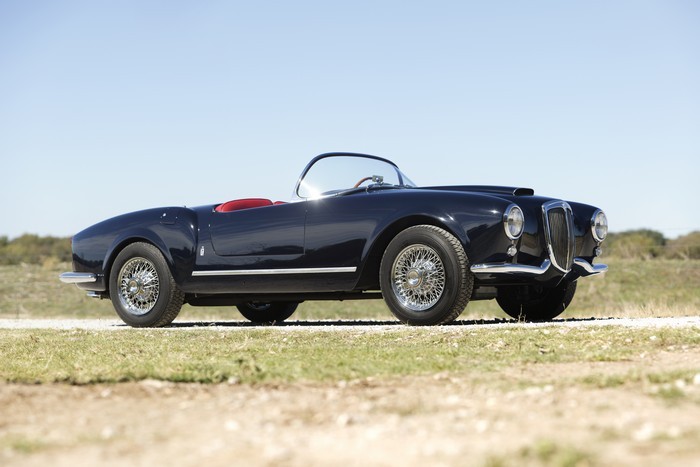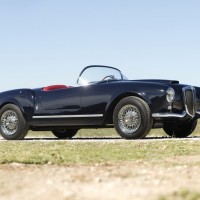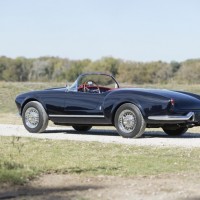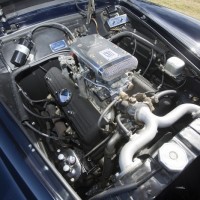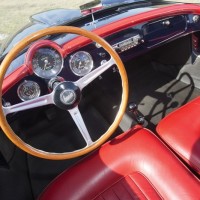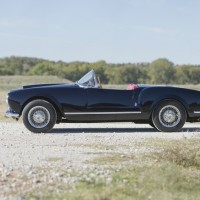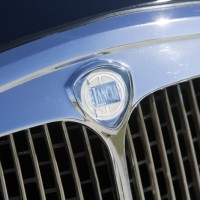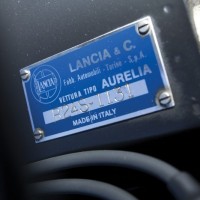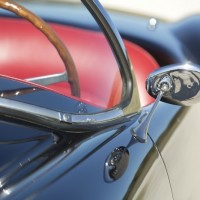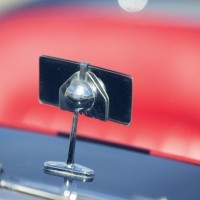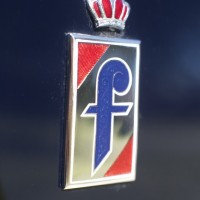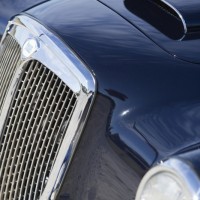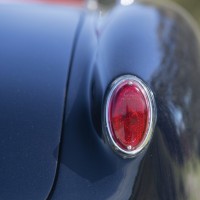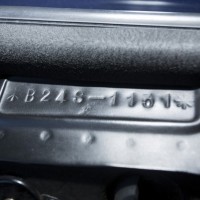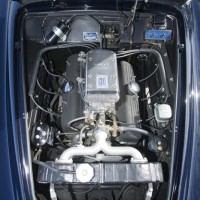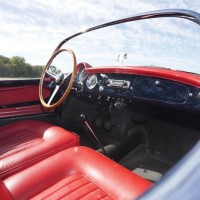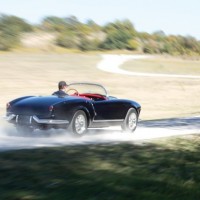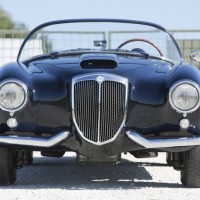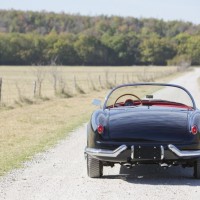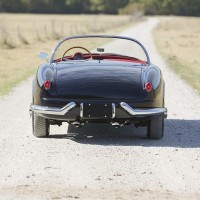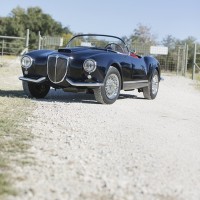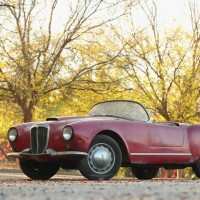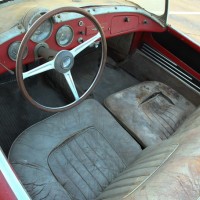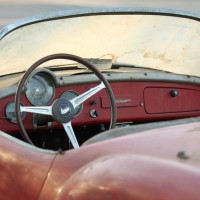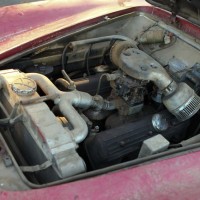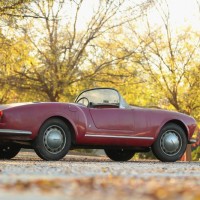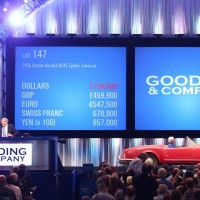Lancia Aurelia B24 S Spider America 1131
This car is among the rare survivors, having resided for its entire life in the forgiving western United States. In 1992, it was owned by the president of the U.S. Lancia club, who also was an avid vintage racer. He had the car cosmetically restored by Italian Lancia expert Franco dePiero, and his full-time mechanic restored the car’s numbers-matching drivetrain. During the restoration, the original Weber carburetor was replaced with a period-correct Nardi twin-carburetor conversion setup — which, along with the Borrani center-lock wire wheels and the signature Nardi steering wheel, completes the highly desirable Nardi package. Today, this remarkable Spider remains in high-point condition, a testimonial to both the quality of the car before restoration — and the caliber of the restoration itself. Only minor evidence of aging can be found upon close examination, but with careful use, the car will mellow gracefully, gradually acquiring the patina of a lovely, untouched original. These stunning Spiders are highly prized by their intensely loyal owners. They offer a nearly ideal combination of desirable characteristics: They are fast, with delightfully nimble handling, quick and responsive steering, and undeniable grace and beauty. Their racing bloodlines and thoroughly sporting manner make them not only eligible for, but ideal candidates to participate in, any important driving event worldwide. They are seldom, if ever, offered. Within the U.S, only a handful survive of this quality.Lancia Aurelia B24 S Spider America 1123
In summer 1956, John Jang walked into British Motor Car Distributors, his favorite sports-car dealership, on Van Ness Avenue in San Francisco. The car was tilted sideways at a high angle, with mirrors placed underneath to show the B24’s innovative inboard rear brakes and distinctive suspension design. Fascinated, Mr. Jang asked that the car be taken down for a test drive. The drive went so well that he traded his $3,000 1953 Porsche Cabriolet, which he had bought only a month before, toward the purchase of the $5,600 Lancia and drove it home to Oakland. His red Lancia was still in his Northern California garage 56 years later. In 1963, the young couple moved from the Bay Area to Sacramento; the Lancia Aurelia made the move to the new house but was never driven again. A padlock was placed on the wooden overhead garage door, and the Aurelia was kept under a cover for the next 49 years. In December 2012, the Jangs made the decision to sell the red Spider America, asking a trusted family friend to assist them in bringing it to market. The Jangs’ Spider America showed just over 28,000 original miles at the time of cataloging. The original gray leather interior is dry but mostly intact. The engine turns over freely in its dusty compartment and appears absolutely complete and original. The electrical system functions as it did in period, numerous factory markings have been found, and the entire car presents as only an undisturbed, low-mileage car can. The rare Plexiglas removable side windows were found stored along with the original tools, jack and spare wheel. The original rearview mirror and even the headlight rings, which have not been mounted on the car in over 50 years, were found in the lower recesses of the trunk.SCM Analysis
Detailing
| Vehicle: | 1955 Lancia Aurelia B24 S Spider America |
| Years Produced: | 1955 |
| Number Produced: | 240 |
| Original List Price: | $5,500 |
| Chassis Number Location: | On firewall, stamped in center of engine compartment and on chassis plate |
| Engine Number Location: | Stamped on right side of block |
| Club Info: | American Lancia Club |
| Website: | http://www.americanlanciaclub.com |
Aurelia B24 S Spider America 1131 — restored — sold for $825,000, including buyer’s premium, at the RM Auctions Arizona sale in Phoenix, AZ, on January 18, 2013. Aurelia B24 S Spider America 1123 — unrestored — sold for $803,000 at the Gooding & Company auction in Scottsdale, AZ, on January 19, 2013.
Back in 2011, I wrote a double profile on a pair of Siata 208Ss that were sold in the space of two days by RM Auctions and Gooding & Company (November 2011 Etceterini Profile, p. 44). It was a “compare and contrast” essay, focusing on what we appraisers call attributes of value in an effort to explain why two restored cars — both Pebble Beach veterans — could sell in arguably the same market $621,500 apart.
This pairing of two Lancia Aurelia B24 S Spider Americas is a bit different — or at least appears so at first glance. You have a shiny restored car and a complete and rather original barn find, and you would expect them to sell at very different prices. Instead, these two seeming opposites brought almost exactly the same price. What? How can it be?
The coming to auction market of these cars set the wires ablaze with speculation. Since Gooding’s sale of a B24 S convertible at their 2012 Scottsdale sale for $561,000, a question had hung in the air — if this was more than an anomalous outlier sale, did the historical record of Spiders selling for roughly twice as much as convertibles mean that a well-done Spider could sell for $1m?
I knew that there were several owners holding Spider Americas in various states of dereliction, and that a number of them were eagerly awaiting the answer to that question.
The nature of the two cars on offer in Arizona 2013 complicated the question.
First, a pedantic point: Both cars were referred to as 1956 cars, due no doubt to the date on their titles. There are no 1956 Spider Americas, as all were built in 1955. Also, I will take another shot at debunking that hoary tale of the “Lost on the Andrea Doria Spider Americas.” It didn’t happen and couldn’t have happened, as the Andrea Doria sank in July 1956, when B24 convertible production was well under way. Although many Spider Americas were sold in 1956 (and some in 1957 as well), there is no record of any being shipped from Italy in 1956. So, when you read this tale again, immediately snort and roll your eyes.
Barn find versus preservation
I’ll not take a lot of time here to discuss — yet again — Barn Find Mania, but I will go over the difference between the phrase “barn find” and the word “preserved.”
The 1953 Fiat 8V Ghia Supersonic that Gooding sold in Scottsdale, AZ, in January 2011 (they will offer it again at Amelia Island 2013, after this article went to press) is an almost totally original and well-kept “preserved” car. For example, 95% of the still-shiny paint is still on the car, the interior boasts original and still-supple leather, and it even had the hand-stitched cover that protected it on its journey from Italy to America when new.
Moss never covered it, trees never grew through it, paint never flaked off of it (except on the passenger’s grab handle) and squirrels never nested in its engine compartment. It had various small touch-ups, some from the 1950s, some from a few years ago, and that’s about it.
In contrast, most “barn finds” are cars which at some point in their history had been abandoned or at least neglected while parked, with corresponding deterioration. Even if a car has not been “preserved” in any real sense of that word, the appeal of a car that has not been taken apart for a restoration is still strong.
It is especially so for cars such as these Lancias. Although they were built in serial production, the level of hand-finishing of panels is almost as high as in a one-off, bespoke vehicle. The doors fit on a particular car because they were essentially created for that particular chassis.
Not a preservation car
The Spider at Gooding (1123) had extraordinary panel fit, especially the doors. It was as if the gaps were drawn on a solid panel with a Sharpie marker. Was it a preservation candidate? Not for me.
The car had been at least partially repainted, probably due to the everyday scrapes and dings a car in use acquires. The front bumper, with its neat original accessory middle protection bar, was slightly bent, evidence of a minor close encounter.
So, while the paint might shine up a bit, why preserve it? Inside, the seat leather was like peanut brittle — split, cracked and ready to break off at the next touch. Some on the scene posited that it might be salvageable, but the matching leather trim strip at the base of the windshield had shrunk to invisibility, and it would have to be replaced. Once that was done, you couldn’t leave the old seats, and so on.
But the car’s very originality — with the debris grilles intact below the oil filler cap and the original pins in the soft top latches — makes it the perfect candidate for a correct, high-level restoration.
A restored car with issues
Over at RM, their Spider had been the beneficiary of a very good restoration at an Italian specialist’s shop — and appeared to have been well used and enjoyed since. The later fitting of a Nardi twin-carburetor manifold along with wire wheels were nice touches.
However, the true Nardi Kit also included revised camshafts, and there’s no mention of that. Of course, cars that had the Nardi equipment in period are much desired, and when properly documented, can command a healthy premium.
The condition of the car as I examined it was rather more worn. For example, there was extensive deterioration of rubber gaskets, particularly those around the taillights. The pins in the soft-top windshield header latches were both incorrect and broken. There were areas showing extensive wear on the soft trim of the interior and the sides of the seats.
More troubling was the front grille. The Lancia shield grille piece rests on a metal panel shaped to fit exactly along the sides and top. On this car, there was a space of approximately a quarter-inch on the right side. It was indication of either casual bodywork on the front end or the use of an improperly shaped replacement grille. In any case, it was not indicative of a car finished to the highest standards.
At the very least the RM car (1131) would need a freshening, and once that starts, it generally becomes a restoration. I know, as I’ve been there.
Okay, I’ve now determined that to make either of our Spider Americas a really good example, some level of restoration is required. So, it makes some sense that they would sell for near-identical money, as they are both destined for the shop. That said, the RM car (1131) will need much less work.
Why similar money for such different conditions?
Now we come to the prices paid. The Aurelia B24 Spider America is a fabulous car to drive, is one of the sexiest shapes to come from Pininfarina in the 1950s and showcases Lancia’s brilliant engineering.
Compare the B24 Spider America to its near-contemporary — the BMW 507. The BMW is a beautiful car, but it is hardly groundbreaking and a complete cul-de-sac in the history of its maker. They have regularly sold for over $1m for years. The Lancia is at least its equal in use — if not in horsepower — and should be as valuable.
If you agree that both of our subject Lancias should be restored and accept that a national/international-show-level restoration of a Spider America can easily run to $150k–$250k if there is nothing missing — or if that which is can be easily located or replicated — you then have a $1m car. That more wasn’t paid for the RM car proves that the buyer (and underbidder) did his homework and bid accordingly.
That so much was spent for the car at Gooding (1123) demonstrates the value of a sound, honest and well-documented restoration candidate. I would have to call both of these cars correctly bought — even if well sold. ?
(Introductory descriptions courtesy of Gooding & Company and RM Auctions.)
